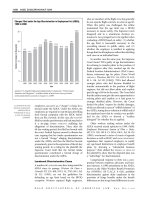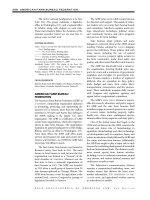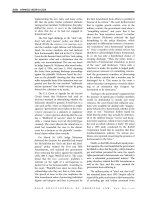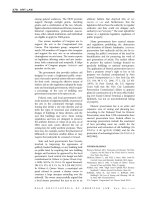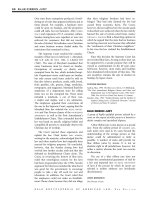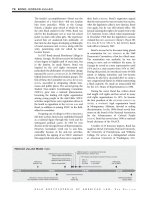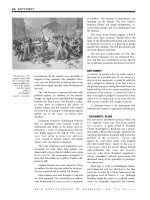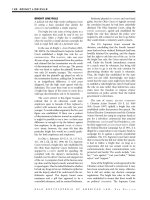Gale Encyclopedia Of American Law 3Rd Edition Volume 3 P30 pptx
Bạn đang xem bản rút gọn của tài liệu. Xem và tải ngay bản đầy đủ của tài liệu tại đây (259.2 KB, 10 trang )
A sample plain-
language credit
cardholder agreement
(continued).
ILLUSTRATION BY GGS
CREATIVE RESOURCES.
REPRODUCED BY
PERMISSION OF GALE,
A PART OF CENGAGE
LEARNING.
18. Other Charges. The Total Other Charges is the sum of:
a. Membership Fee. We charge a membership fee of $0 per year, which will be billed to your account during the same “renewal
month” each year. If we assign your account a renewal month other than the month of your first billing statement, we may assess a
partial Membership Fee prorated for the period until the first renewal month. All Membership Fees are payable when posted to your
account and are non-refundable except as otherwise provided for by law. This annual fee shall be treated as a credit purchase for
purposes of calculating Finance Charges unless prohibited by law.
b. Late Charge. If we do not receive at least your minimum required payment within 10 days after the closing date subsequent to
the payment due date indicated on your billing statement, we will impose a late or delinquency charge of $25.00.
c. Overlimit Charge. Each time your New Balance exceeds your maximum authorized credit we will impose an Overlimit Charge
of $25.00.
d. Replacement Card. We reserve the right to charge you $15.00 to replace a card.
e. Non-Sufficient Funds. We reserve the right to charge $25.00 for non-sufficient funds.
19. If You Change Your Name or Address. You agree to notify us in writing within twenty days if you change your name, your home or
mailing address, or home or business telephone number.
20. Our Right to Cancel Your Account. We can cancel your account at any time, or reduce the amount of your credit line, without notice
to you, except in those situations where notice is required by law. If we cancel your account, you agree to destroy all Cards issued on your
account by cutting them in half and returning them to us. You will continue to be responsible for full payment of the balance on your
account and all charges to your account, including those not yet received by us, as well as subsequent Finance Charge and other charges.
Each Card is our property, and you agree that the Cards are not transferable and to surrender any Card upon demand.
21. Change in Terms of Your Account. We can change any terms of your account at any time. We will provide you with such notice as is
required by law by mailing a notice to you at the latest address shown in our records. Subject to applicable law, any change will apply to
the current balance of your account, as well as to future balances.
22. If Your Card is Lost or Stolen or if an Unauthorized Use May Occur. You agree to notify us immediately if your card is ever lost or
stolen or if an unauthorized use may have occurred. The telephone number to call is (800) 325-3678, and you agree to follow up your call
with notice in writing to us at: Credit Card Security Department, P.O. Box 30035, Tampa, Florida 33630. You also agree to assist us in
determining the facts, circumstances and other pertinent information relating to any loss, theft or possible unauthorized use of your credit
card and comply with such procedures as we may require in connection with our investigation, including assisting in the prosecution of
any unauthorized user.
23. Liability for Unauthorized Use of Credit Card. We may hold you liable for the unauthorized use of your credit card. You will not be
liable for unauthorized use that occurs after you notify us orally or in writing of the loss, theft, or possible unauthorized use. In any case,
your liability will not exceed $50.00.
24. Credit Information. You agree that we may release information to others, such as credit bureaus, regarding the status and history of
your account. However, we are not obligated to release any such information to anyone unless we are required by law to do so.
25. Waivers. If, for any reason, we do not make use of any of our rights under this Agreement on a particular occasion, that will not
limit our rights in the future in any way.
26. Our Address. To send payment: Payments must be sent to the address listed on the front of the billing statement after the phrase
“make check payable to.” To inquire or send correspondence: Write us at the address indicated on the front of the billing statement after
the phrase “send inquiries to.”
27. Important Notice to Our Customer Who Contacts Us by Phone. Cardholder agrees that Issuer, its agents and service companies
may, without the need to seek additional confirmation from Cardholder, monitor and/or record any telephone communications with
Cardholder to insure that inquiries from you are handled promptly, courteously, and accurately.
28. Visa Rules and Regulations. The services being provided to you under this Agreement are made possible by Issuer’s status as a
licensee of Visa U.S.A. You recognize Issuer’s responsibility to comply with the current Visa U.S.A. rules and regulations and changes to
them in order to continue to provide these services. Visa cards may not be used for any illegal transaction.
29. Regulation Z Initial Disclosures. By using your card, you acknowledge receipt from us of the Initial Disclosures required by
Regulation Z of the Truth-In-Lending Act and that the terms contained in the Initial Disclosures apply to you and your use of the card and
are incorporated in full into this Agreement. The information about the terms and costs of the Card described in this Customer Agreement
is accurate as of the Effective Date. This information may have changed after that date. To find out what may have changed, call us or write
to us.
Write to: Erie Shores Credit Union, Inc.
P.O. Box 9037
1688 Woodlands Drive
Maumee, OH 43537
Call at: (800) 248-8110 or
(419) 897-8110
Plain-language Cardholder Agreement
GALE ENCYCLOPEDIA OF AMERICAN LAW, 3RD E DITION
278 CREDIT
account due once a month. An individual might
also be extended a credit line, the maximum
amount of money that a lender will put at a
borrower’s disposal. In such case, an individual
enters into an agreement for the taking out of
a series of loans. Because there is a fixed
limitation on the amount to be borrowed,
payments must be made to reduce the debt
incurred when the maximum is reached.
A
LETTER OF CREDIT, sometimes called a
creditor’s bill, is a written instrument from a
bank or merchant in one location requesting
that anyone, or some specifically named indi-
vidual, advance money or items on credit to the
individual holding, or nam ed in, the letter.
Repayment of the debt is guaranteed by the
bank or merchant issuing the letter. Letters of
credit are popular in international commercial
transactions because they enable parties to
transact business without the need to exchange
large amounts of cash. This type of instrument
was also popular prior to the common usage of
credit cards and travelers’ checks.
Personal credit is granted based upon an
individual’s character, reputation, and business
standing regarding his or her financial reliability.
Development of the Law of Credit
Traditionally, the law has sought to protect
borrowers since they are easily exploitable by
lenders. Often the two parties do not have equal
bargaining opportunities to negotiate all the
terms of the agreement, and, therefore, the
stronger is able to take advantage of the more
vulnerable. The established legal viewpoint is
that a lender can properly charge a fee for use of
the funds he or she lends, but the rate of interest
should be neither unfair nor unconscionable.
Usury traditionally meant charging interest
or a fee in exchange for a loan, but it has come
to mean charging an illegal rate of interest.
Certain credit transactions, such as the loan of
money pursuant to a mortgage, are exempt
from the provisions of usury statutes.
Amortization Amortization—a system that
allows a borrower to discharge a debt in regular,
equal installments—was developed in the nine-
teenth century by savings and loan associations.
To amortize a loan, the lender must calculate
the total interest due over the term of repay-
ment, add that figure to the total sum borrowed,
and divide the total by the number of payments
to determine the size of regular, periodically
scheduled payments to be made by a debtor.
Morris Plans The establishment of Morris plan
companies, still found in some states, was a
significant development in the consumer credit
business. These industrial banks accept deposits
from the general public and issue investment
certificates in the amount of each deposit. The
certificates entitle the holder to obtain interest
on a deposit at regularly scheduled intervals. The
bank utilizes the funds primarily to make small
loans to wage earners who are steadily employed.
It is necessary for borrowers to secure two other
salaried individuals to endorse the agreement.
The loan is repaid in installments during the
course of a one-year period.
State Consumer Laws Originally the fact that
consumer loans were difficult to obtain created
loan sharking—the practice of lending money at
usurious interest rates—coupled with the threat
or use of extortionate methods of enforcing
repayment. The Russell Sage Foundation ana-
lyzed the
LOAN SHARK problem in 1916 and
suggested that credit should be made available
to consumers. It proposed a Uniform Small
Loan Law for enactment by the states that
defined small loans as those under $300. A
maximum interest rate of three and one-half
percent monthly on small loan s was suggested.
The interest rate was stated as a per-month
charge in order to encourage legislators to adopt
the act and to prevent consumers from going to
loan sharks who make a practice of concealing
their true rates of interest.
The Uniform Small Loan Law was subse-
quently revised but was important because it
made way for legal lend ing to consumers. It was
created as an exception to state usury laws and
furnished the pattern for the subsequent crea-
tion of consumer credit legislation.
Legal Rate of Interest
Interest can be computed in a number of ways,
and creditors generally attempt to use the most
profitable way that is within legal limits. In
figuring the legal rate of interest, it is essential to
determine which expenses are a part of the
finance or interest charges. Not customarily
considered components of finance charges are
fees for filing or recording a document, for
payment of an individual who does an appraisal,
and for the expense of preparing documents;
closing costs; and prepayment penalties.
GALE ENCYCLOPEDIA OF AMERICAN LAW, 3RD E DITION
CREDIT 279
CREDIT BUREAU
A privately owned, profit-making establishment
that—as a regular business—collects and compiles
data regarding the solvency, character, responsi-
bility, and reputation of a particular individual or
business in order to furnish such information to
subscribers, in the form of a report allowing them
to evaluate the financial stability of the subject of
the report.
Credit bureaus ordinarily prepare and issue
reports for lending institutions and stores that
investigate the financial reliability of an appli-
cant for credit prior to the execution of the
credit agreement.
Credit bureaus are regulated by the federal
FAIR CREDIT REPORTING ACT (15 U.S.C.A. § 1681
et seq. [1970]) and by state statute to safeguard
against abusive and damaging practices.
CRÉDIT MOBILIER SCANDAL
The Reconstruction era after the CIVIL WAR was a
time of chaos, reorganization, and corruption
that affected not only lesser state officials but
also federal government agents. The Crédit
Mobilier affair, which had its early beginnings
in 1864 but was not publicly investigated until
1873, is an example of the corrupt practices that
characterized the period.
In 1864, Thomas C. Durant, an administrator
of the Union Pacific Railroad, bought the
Pennsylvania Fiscal Agency, which was chartered
in 1859. The agency was renamed Crédit Mobilier
of America and its proposed purpose as a
construction company was the building of the
Union Pacific Railroad. The federal government
had granted the railroad generous loans and
contracts for its construction, and the adminis-
trators of the railroad planned to divert this
money into the Crédit Mobilier Company,
allowing the stockholders of the company to
enjoy huge profits. Government officials first
became involved in 1865 when Oakes Ames,
congressional representative from Massachusetts,
and his brother Oliver bought shares of stock in
the Crédit Mobilier and, indirectly, in the Union
Pacific Railroad. The Ames brothers soon became
the power behind the Union Pacific, and, in 1866,
Durant was replaced by Oliver Ames.
The building of the railroad was fraudulently
financed for approximately $50 million more
than was necessary. In addition, Oakes Ames sold
a large number of shares of stock in Crédit
Mobilier at a reduced rate to several of his fellow
congressmen. This move on the part of Ames
was to allay any suspicious interest in the
undertakings of the two companies and to
Cartoonist Joseph
Keppler offered a
satirical portrayal of
the Crédit Mobilier
Scandal by depicting
politicians involved in
the affair as residents
in a hospital ward. In
actuality, punishment
was lenient:
Representatives James
Brooks and Oakes
Ames were merely
censured.
CORBIS.
GALE ENCYCLOPEDIA OF AMERICAN LAW, 3RD E DITION
280 CREDIT BUREAU
encourage legislation beneficial to the railroad.
This maneuver occurred in 1867, and for the next
five years rumors surrounding the activities of
Ames and other government officials circulated.
The scandal erupted in 1872 when the details
of the Crédit Mobilier Company became an
issue of the presidential campaign of that year.
Several important officials were involved includ-
ing vice presidential candidate Henry Wilson,
incumbent
VICE PRESIDENT Schyler Colfax, future
president and member of the House of Repre-
sentatives
JAMES A. GARFIELD, and Speaker of the
House James G. Blaine. An investigation began
in 1873. The punishments for such behavior
were surprisingly lenient, however, and the
Crédit Mobilier Company and Congressman
Ames were merely publicly censured.
CREDIT UNION
A corporation formed under special statutory
provisions to further thrift among its members
while providing credit for them at more favorable
rates of interest than those offered by other lending
institutions. A credit union is a cooperative
association that utilizes funds deposited by a
small group of people who are its sole borrowers
and beneficiaries. It is ordinarily subject to
regulation by state banking boards or commis-
sions. When formed pursuant to the Federal
Credit Union Act (12 U.S.C.A. § 1751 et seq.
[1934]), credit unions are chartered and regulated
by the National Credit Union Administration.
A credit union can be distinguished from
other financial institutions by the fact that
membership is ordinarily restricted to indivi-
duals who meet certain residential or occupa-
tional criteria. In addition, it can make loans of
a more diversified nature than certain institu-
tions, such as building and loan associations.
CREDITOR
An individual to whom an obligation is owed
because he or she has given something of value in
exchange. One who may legally demand and
receive money, either through the fulfillment of a
contract or due to injury sustained as a result of
another’s negligence or intentionally wrongful act.
The term creditor is also used to describe an
individual who is engaged in the business of
lending money or selling items for which immedi-
ate payment is not demanded but an obligation of
repayment exists as of a future date.
An attachment creditor is an individual who
has obtained an order of attachment from a
court to command a sheriff to seize the property
of a debtor who has defaulted in the repayment
of an outstanding obligation so that the
property may be used to satisfy the creditor’s
claim.
A judgment creditor is a party who has gone
to court and obtained a judgment against the
person who owes him or her money. If that
judgment creditor obtains an order of attach-
ment, he or she becomes an attachment
creditor.
A
GENERAL CREDITOR or creditor at large is an
individual who has neither a lien nor a security
interest in the property of the debtor.
A junior creditor is one whose right to collect
money from a debtor is subordinate to that of
another individual who also has a right to
collect payment of a different debt from the
same debtor. The person with the primary right
to payment is known as a senior creditor.
A principal creditor is the party who has a
claim against the debtor that is far greater than
the debt owed to any other creditor, and in
some instances, to all other creditors combined.
A
SECURED CREDITOR holds a special LEGAL
RIGHT
in particular property of the debtor to
assure him or her of repayment of the debt.
A creditor who has the protection of a lien or
mortgage is secured.
A single creditor has a lien on only one of the
debtor’s funds or accounts.
Petitioning creditors are those parties to
whom one debtor owes money and who apply
to the court of
BANKRUPTCY in order to secure the
debtor’s property and distribute it equitably
among them.
CREDITOR’S BILL
An equitable proceeding initiated by a person who
has obtained—and is entitled to enforce—a
money judgment against a debtor to collect the
payment of a debt that cannot be reached through
normal legal procedures.
A
PLAINTIFF might, for example, win a lawsuit
against a
DEFENDANT whereupon the defendant
might be ordered to pay damages. In the event
that the defendant does not pay promptly, the
usual way for the plaintiff to obtain payment is
to pay a certain designated fee to the sheriff who
GALE ENCYCLOPEDIA OF AMERICAN LAW, 3RD E DITION
CREDITOR’ S BILL 281
would seize the defendant’s property, sell it, and
pay the plaintiff with the proceeds. If, for
example, the defendant only has property that is
worth less than the plaintiff’s judgment, the
plaintiff creditor might pursue the defendant’s
rights to collect money from others. The person
can then initiate a creditor’s bill, also known as
creditor’s suit, requesting that the court autho-
rize a way to obtain the money affected by such
rights. Such funds as those that come from
corporate stock, annuity checks, growing crops,
and money owed to the debtor from another
person can all be subjected to creditors’ suits.
A creditor’s bill cannot, however, be used to
obtain a liquor license, property in another
state, or future unearned wages or salary.
CRIME CONTROL ACTS
The vast majority of substantive criminal
statutes may be characterized, in one way or
another, as “crime control acts.” The term
“crime control act ” is often used in the titles of
comprehensive bills that can be hundreds of
pages long. These acts can identify a broad array
of new crimes, revise existing criminal laws,
enhance sentencing and other penalties attached
to those crimes, and finance the provisions of
these bills. Congress enacted a series of crime
control statutes, especially during the late
twentieth century, that has introduced a myriad
of new forms of
CRIMINAL LAW at the federal level,
including provisions prohibiting
MONEY LAUN-
DERING
, CARJACKING, drug enforcement, CRIMINAL
FORFEITURE
, and offenses under the Racketeer
Influenced and Corrupt Organizations Act.
According to the Task Force on Federaliza-
tion of Criminal Law of the
AMERICAN BAR
ASSOCIATION
, only an “initial handful ” of federal
statutes existed at the turn of the nineteenth
century, as federal criminal law consisted of a
total of 17 statutes. Throughout the nineteenth
century, federal criminal statutes were fairly
narrow, generally protecting only federal inter-
ests and interests where the states held limited
power to address a particular form of crime.
The number of federal crimes, however, grew
considerably toward the latter part of the
nineteenth century and into the early twentieth
century. By the 1930s Congress sought to
address concerns that crime had become
rampant across the United States, and that
states had difficulty handling the increase of
crime effectively.
Many of the fede ral criminal statutes in the
1930s addressed specific forms of criminal
activity, such as
KIDNAPPING, RACKETEERING,
SECURITIES FRAUD, and the illegal use and sale
of firearms. In 1934 C ongress enacted a series
of statutes known as the Crime Control Acts,
chs. 299-304, 48 Stat. 780-83 (codified as
amended in scattered sections of 18 U.S.C.A.).
These acts included provisions for punishment
for killing and assaulting federal officers,
EXTORTION, transportation of kidnapped per-
sons, and interstate flight, as well as provisions
defining crimes in connection with the admin-
istration of federal prisons and crimes commit-
ted against banks operating under the laws of
the United States.
Although the number of federal crime s
continued to grow throughout the twentieth
century, the perception persisted that crime was
rampant throughout the United States, particu-
larly during the turbulent times of the 1960s.
Faced with the high incidence of crime
throughout the country, Congress enacted the
Omnibus Crime Control and Safe Streets Act of
1968, Pub. L. No. 90-351, 82 Stat. 197 (codified
as amended in scattered sections of 18 U.S.C.A.).
When enacting this legislation, Congress ac-
knowledged that crime is fundamentally a state
and local problem, and that it requires the efforts
of state and local law enforcement in order to
control crime effectively. The 1968 statute
encouraged states and units of local government
to prepare and adopt comprehensive plans to
address crime in those particular states or
localities. Under the statute, Congress also
authori zed grants to the states and local
entities to strengthen a nd improve law en-
forcement, and encouraged research and
development that would be aimed at the
imp rovement of law enfor cement methods,
the reduction of crime, and th e detection and
apprehension of criminals.
Included within the original Omnibus
Crime Control and Safe Streets Act were a
number of controversial provisions regarding
wire intercepting and interception of oral
communications, as well as measures to allow
states and local agencies to control firearms at
the local level. The provisions contained in this
act have been amended and revised dozens of
times since the initial 1968 enactment.
The federalization of criminal law continued
during the 1970s. The Crime Control Act of
1973, 93-83, 87 Stat. 197 (codified as amended
GALE ENCYCLOPEDIA OF AMERICAN LAW, 3RD E DITION
282 CRIME CONTROL ACTS
in scattered sections of 18 U.S.C.A.) serviced the
same general purpose as the Omnibus Crime
Control and Safe Streets Act. Its primary
purpose was to provide grants and other
funding to law enforcement agencies in their
fights against crime at the state and local levels.
Three years later, Congress approved the Crime
Control Act of 1976, Pub. L. No. 94-503, 90
Stat. 2407 (codified as amended in scattered
sections of 18 U.S.C.A.). The 1976 act estab-
lished the Office of Community Crime Pro-
grams and other measures that were designed to
enhance the ability of local law enforcement
agencies.
Although federal criminal law had under-
gone a metamorphosis in the 1960s and 1970s,
the federal criminal code had not undergone a
comprehensive revision since the early 1900s. In
1984 Congress wrangled with a major bill that
would provide this comprehensive revision,
eventually enacting the Comprehensive Crime
Control Act of 1984, Pub. L. No. 98-473, 98
Stat. 1976. Although controversial sections of
the original bill related to
CAPITAL PUNISHMENT,an
exception to the
EXCLUSIONARY RULE in CRIMINAL
PROCEDURE
, restrictions on HABEAS CORPUS pro-
ceedings in federal courts, and liability of the
government for
CIVIL RIGHTS violations were
removed before the bill was passed, the final
draft of the legislation was not satisfactory
to several members of Congress. Within days
of the passage of the Comprehensive Crime
Control Act, Congress enacted the Criminal
Fine Enforcement Act, Pub. L. No. 98-596, 98
Stat. 3134, which repealed some of the provi-
sions of the Comprehensive Crime Control Act
soon after they became effective. Nevertheless,
the provisions that remained intact were
significant in federal criminal law.
Among the new provisions in the Compre-
hensive Crime Control Act were those addres-
sing violent offenses, federal anti-terrorism
provisions, certain economic offenses, con-
trolled substances, and a number of other
miscellaneous crimes. One of the more impor-
tant measures in the act included a new system
governing sentencing for federal crimes. Chap-
ter 2 of the act, the Sentencing Reform Act of
1984, established the United States Sentencing
Commission, which is responsible for drafting
and revising the Federal Sentencing Guidelines.
The first of these sentencing guidelines went
into effect in 1987, although they have been
amended significantly since then. The Federal
Sentencing Guidelines not only have changed
the sentencing procedures in federal courts, but
also have affected the ways in which state courts
approach sentencing.
Comprehensive crime control legislation
continued into the 1990s. The Crime Control
Act of 1990, Pub. L. No. 101-647, 104 Stat. 4789
further revised provisions of previous crime
control statutes. Four years later, Congress
addressed problems associated with violent
crimes with the enactment of the
VIOLENT CRIME
CONTROL AND LAW ENFORCEMENT ACT OF
1994, Pub.
L. No. 103-322, 108 Stat. 1796. That statute
increased and enhanced punishment for violent
offenders, including punishment of young
offenders. The statute included numerous
provisions regarding crime prevention. Some
of the more controversial provisions of this act
were contained in title IV of the statut e, known
as the Violence Against Women Act. Although
the statute has increased funds for research and
education to enhance knowledge and awareness
for judges and judicial staff in matters involving
DOMESTIC VIOLENCE and sexual ASSAULT,the
original statute also contained a measure that
would make gender-motivated crimes a viola-
tion of federal civil rights law. The U.S.
Supreme Court, in United States v. Morrison,
529 U.S. 598, 120 S. Ct. 1740, 146 L. Ed. 2d 658
(2000), struck down the latter provision as
unconstitutional.
Other crime control acts have addressed
specific areas of concern with respect to crime.
The
ORGANIZED CRIME Control Ac t of 1970, Pub.
L. No. 91-452, 84 Stat. 922, for instance,
addressed specific problems relating to orga-
nized crime, including the establishment of
protected facilities to house government wit-
nesses. The ongoing war against drugs has
similarly led to the enactment of comprehensive
legislation, including the Anti-Drug Abuse Act
of 1986, Pub. L. No. 99-570, 100 Stat. 3207 and
the Anti-Drug Abuse Act of 1988, Pub. L. No.
100-690, 102 Stat. 4181.
Scholars have criticized the continued
growth of the federalization of criminal law, as
Congress continues to enact these comprehen-
sive crime control bills. Fe deral criminal law
consists of more than 3,000 individual criminal
offenses, many times more than the number
that existed a century ago. Supporters of these
bills note, however, that state and local officials
have not shown the ability to address many
of the criminal problems that are addressed
GALE ENCYCLOPEDIA OF AMERICAN LAW, 3RD E DITION
CRIME CONTROL ACTS 283
under the new federal laws, and that federal
law enforcement is in a b etter position to
conduct the type of investigation that is
necessary to curb incidents of crime through-
out the country.
FURTHER READINGS
Abrams, Norman, and Sara Sun Beale. 2008. Federal
Criminal Law and Its Enforcement. 4th ed. Eagan,
Minn.: West.
George, B. James, Jr. 1985. The Practical Guide to the
Comprehensive Crime Control Act of 1984. Frederick,
Md.: Aspen.
Partridge, Anthony. 1985. The Crime Control and Fine
Enforcement Acts of 1984: A Synopsis. Washington, D.C.:
Federal Judicial Center.
Strazzella, James A., ed. 1996. The Federal Role in Criminal
Law. Thousand Oaks, Calif.: Sage.
CROSS REFERENCES
Criminal Law; Criminal Procedure; Sentencing.
CRIMES
Acts or omissions that are in violation of law.
Each state in the United States, as well as the
federal government, maintains a body of
criminal laws. As populations have increased
and personal interactions and business transac-
tions have grown more complicated, criminal
laws have likewise grown in number and
complexity. Most jurisdictions codify criminal
statutes in a separate section in their laws.
However, some crimes are placed in chapters or
titles outside the designated criminal code.
Generally, criminal laws are divided into several
broad categories: offenses affecting public order,
health, and morals; offenses involving trade,
business, and professions; and offenses against
the family. These categories often overlap.
Juveniles and minors generally receive special
treatment under criminal statutes.
Offenses Affecting Public Order,
Health, and Morals
A number of acts are made criminal to preserve
public order, health, and morals. Some of these
laws are based in the
COMMON LAW but have
undergone significant changes over the years.
PROSTITUTION, if discreet and practiced indoors,
was generally tolerated in colonial America, but
streetwalkers were charged under lewdness,
VAGRANCY, or similar laws. In the late nineteenth
century, states began to identify and prohibit all
prostitution, in criminal statutes, where it was
defined as engaging in sex for hire. Prostitution
is now illegal in all states except Nevada, where
it is strictly regulated.
Pandering, or inducing another into prosti-
tution, is illegal in all states, including Nevada.
The solicitation of prostitution is illegal in all
states except Nevada, where it is allowed only in
licensed brothels.
Public obscenity laws find their roots in the
religious prohibitions of blasphemy and heresy,
or defiance of the church. Laws prohibiting
blasphemy and heresy were passed in colonial
America, but after the passage of the
FIRST
AMENDMENT
in 1791, states began to focus
obscenity statutes on material with a sexual
content. In 1996, the U.S. Congress passed the
Telecommunications Act of 1996, Pub. L. 104-
104, Feb. 8, 1996, 110 Stat. 56, which included
criminal punishment for the trans mission of
obscenity throu gh cyberspace.
The definition of obscenity is generally a
matter of contemporary community standards.
In New York, for example, any material or
performance is obscene if “the average person,
applying contemporary commun ity standards,”
would find that the predominant effect of
the work as a whole appeals “to the prurient
interest in sex” (N.Y. Penal Law § 235.00
[McKinney 1995] ). To be defined as obscene,
the material or performance must also depict or
describe “in an offensive manner, actual or
simulated: sexual intercourse, sexual
BESTIALITY,
masturbation, sadism, masochism, excretion or
lewd exhibition of the genitals.” Finally, the
material or performance must lack “serious
literary, artistic, political and scientific value”
before its creator can be punished for obscenity.
Obscenity laws include the prohibition of
public profanity. The federal government, for
example, outlaws visible written profanity in the
mails and profanity on radio and television. The
FEDERAL COMMUNICATIONS COMMISSION makes
some exceptions for certain words during
nighttime hours. Profanity, like obscenity, is a
fluid concept, and its treatment is frequently the
subject of legislation.
Gambling is illegal in some states. Other
states allow only certain forms of gambling.
Even where gambling is legal, it is strictly
regulated, and the regulations are enforced by
criminal statutes. For example, persons who
maintain an unlicensed gambling operation in
New Jersey may be charged with a crime of the
fourth degree. Fourth-degree crimes in New
GALE ENCYCLOPEDIA OF AMERICAN LAW, 3RD E DITION
284 CRIMES
Jersey normally carry a penalty of a $7,500 fine
or eighteen months’ imprisonment, or both;
when the crime is unlicensed gambling, fines
may reach $25,000 for individuals and $100,000
for organizations.
The U.S. Congress and state legislatures
prohibit the manufacture, possession, and sale
of certain mood-altering substances, such as
marijuana, cocaine, heroin, and halluc inogens.
Many manufactured drugs yielding psychotro-
pic effects are legal, but only under the
administration of a physician.
All states maintain laws that prohibit the
driving of motorized vehicles while under
the influence of alcohol or other mood-altering
substances. These driving-under-the-influence
(DUI) and driving-while-intoxicated (
DWI)sta-
tutes outlaw or prohibit the drunken driving of
boats and snowmobiles in addition to passenger
vehicles and motorcycles. The range of vehicles
subject to these laws is ever expanding: In 1996 a
Texas man was charged with riding a bicycle
while intoxicated. Intoxication is defined by
statute at a specified blood-alcohol ratio.
Some criminal statutes are mainly designed
to preserve public order. For example, many
states criminalize loitering or prowling. In New
Hampshire, no person is allowed to appear “at a
place, or at a time, under circumstances that
warrant alarm for the safety of persons or
property in the vicinity” (N.H. Rev. Stat. Ann. §
644:6). When challenged, however, many loi-
tering statutes are held by courts to be
unconstitutionally vague.
BREACH OF THE PEACE is a generic description
for a range of
DISORDERLY CONDUCT. Generally,
breach-of-the-peace crimes consist of acts that
disturb public tranquility and order.
STALKING,
or menacing, is the related crime of continually
following or forcing unwanted contact on
another.
The federal Racketeer Influenced and Cor-
rupt Organizations Act (RICO) (18 U.S.C.A. §§
1961 et seq.) is designed to investigate, control,
and prosecute
ORGANIZED CRIME. Many states
have enacted their own
RACKETEERING la ws to
mirror RICO. Essentially, RICO punishes a
pattern of racketeering activity that is accom-
plished through an organized enterprise. Pro-
secutors have broadened the use of RICO to
support an additional criminal charge for even
the most loosely organized crimes. For example,
a person who conspires with another to commit
FRAUD may be charged with fraud and violation
of RICO, if the conspiracy was the product of an
organized enterprise. Youth gangs are among
the organizations subject to RICO laws.
State and federal statutes criminalize the
unlicensed possession of firearms. Firearm
statutes prevent convicted felons from owning a
gun. State and federal laws also place an outright
ban on some models of automatic firearms.
Other criminal laws respecting public order,
health, and morals are many and varied. State
and federal election laws have burgeoned since
the nineteenth century to prohibit a wide range
of acts in connection with the public vote, such
as campaigning on election day, coercing
voters, and engaging in frau d.
IMMIGRATION laws
provide criminal penalties for immigrating
illegally and for hiring illegal immigrants. All
states maintain statutes to punish littering and
the unauthorized dumping or storage of toxic
waste. In Mississippi, dueling is outlawed (Miss.
Code Ann. § 97-39-1), as is cruelty to animals
(§ 97-41-1). In New Hampshire, desecration
of the U.S. flag is punishable as a misdemeanor
(N.H. Rev. Stat. Ann. § 646-A:4).
Offenses Involving Trade, Business, and
Professions
Fraud, THEFT, and misrepresentation are exten-
sively covered in state and federal statutes
concerning virtually every occupation. These
laws prohibit a wide variety of acts ranging from
simulating gemstones and rigging weight scales
to impersonating a doctor or a police officer,
breaching confidentiality, and engaging in
INSIDER TRADING (the buying or selling of publicly
held corporate shares by persons with inside or
advance information regarding the corpora-
tion). The fraudulent use of credit cards is
also the subject of criminal statu tes. And
CABLE
TELEVISION
and computers have inspired a
number of criminal statutes punishing their
abuse; state statutes, for example, punish the
theft of cable television services.
Offenses against the Family
State legislatures enact numerous statutes to
protect people against members of their own
family.
CHILD ABUSE laws make criminal the
physical or mental abuse of a child. Spousal
abuse is also punished under state statutes.
The failure of a parent to pay court-ordered
CHILD SUPPORT is made criminal in state statutes.
GALE ENCYCLOPEDIA OF AMERICAN LAW, 3RD E DITION
CRIMES 285
States work together in apprehending so-called
deadbeat parents through a uniform statute
called the Uniform Interstate Family Support
Act (U.L.A. Unif. Interstate Family Support Act
[1995]). A divorced parent who flees with a
child may be criminally charged under state and
federal
KIDNAPPING statutes as well as CHILD
CUSTODY
statutes.
Juveniles and Minors
Persons under the age of 18, known as juveniles,
are presumed incapable of fo rming the criminal
intent to commit criminal acts. They are, then,
generally immune from prosecution for their
crimes. They can still be held responsible in
juvenile court for committing “delinquent
acts,” which , if they were committed as an
adult, would be considered crimes. However,
a juvenile may be tried for a crime if the
prosecution is able to convince the court to
certify the juvenile as an adult. A prosecutor
generally reserves certification of a juvenile for
serious crimes, such as
MURDER or RAPE. In the
1990s, some state legislatures passed statutes
allowing prosecutors to certify for criminal trial
juveniles as young as age 14.
Minors also warrant special protection from
society. Criminal statutes punish adults for
CONTRIBUTING TO THE DELINQUENCY OF A MINOR.
This crime can be any act that tends to make a
child delinquent. For example, giving a minor
illegal drugs or pornography is criminal under
these statutes. State statutes also criminalize the
sale of other adult materials, such as tobacco
and alcohol, to minors.
FURTHER READINGS
Aquinas, Thomas, Richard J. Regan, and William P.
Baumgarth. 2003. On Law, Morality and Politics.
Indianapolis: Hackett.
Douglas, John E., and Mark Olshaker. 2006. Mindhunters:
Inside the FBI’s Elite Serial Crime Unit. New York:
Arrow.
Richardson, Jeb J. 1998. The Ten Worst Frauds against
America’s Seniors. Fairfax, Va.: Seniors Coalition.
CROSS REFERENCES
Computer Crime; Domestic Violence; Drugs and Narcotics;
Gaming; Juvenile Law.
CRIMINAL
Pertaining to, or involving, crimes or the
administration of penal justice. An individual
who has been found guilty of the commission of
conduct that causes social harm and that is
punishable by law; a person who has committed a
crime.
CRIMINAL ACTION
The procedure by which a person accused of
committing a crime is charged, brought to trial,
and judged.
The main part of a criminal action is the
trial in which the innocence or guilt of the
accused is determined. If the
DEFENDANT is not
found guilty, he or she will be acquitted of the
charges. If the defendant is found to be guilty, a
suitable punishment, such as a fine, imprison-
ment, or even a death sentence, will be imposed
depending upon the punishment provided in
the statute under which he or she was
prosecuted.
CRIMINAL CONVERSATION
A tort under common law that involves the
seduction of another person’s spouse.
A few states still permit a lawsuit for
damages by the injured spouse against the
wrongdoer. Many states have abolished this
action.
Criminal conversation is not the sam e as
ALIENATION OF AFFECTION, which does not neces-
sarily involve the commission of ADULTERY.
CRIMINAL FORFEITURE
The loss of a criminal defendant’s rights to
property which is confiscated by the govern ment
when the property was used in the commission of
a crime. The seizure by law enforcement officers of
an automobile used in the transportation of illegal
narcotics is a criminal forfeiture.
Property that is subject to criminal forfei-
ture is taken from its owner without any
compensation being made because of its use
in illegal conduct. The taking of such property
by the government is an exception to the
principles of condemnation provided that the
item is seized and retained as a result of the
valid exer cise of the
POLICE POWER of the state or
pursuant to constitutional federal statutes.
CRIMINAL LAW
Criminal law includes a body of rules and statutes
that define conduct prohibited by the government
because it threatens and harms public safety and
GALE ENCYCLOPEDIA OF AMERICAN LAW, 3RD E DITION
286 CRIMINAL
welfare and that establishes punishment to be
imposed for the commission of such acts.
The term criminal law generally refers to
substantive criminal laws. Substantive criminal
laws define crimes and may establish punish-
ments. In contrast,
CRIMINAL PROCEDURE describes
the process through which the criminal laws are
enforced. For example, the law prohibiting
MURDER is a substantive criminal law. The
manner in which government enforces this
substantive law—throu gh the gathering of
evidence and prosecution—is generally consid-
ered a procedural matter.
Crimes are usually categorized as felonies or
misdemeanors based on their nature and the
maximum punishment that can be imposed. A
felony involves serious misconduct that is
punishable by death or by imprisonment for
more than one year. Most state criminal laws
subdivide felonies into different classes w ith
varying degrees of punishment. Crimes that do
not amount to felonies are misdemeanors or
violations. A misdemeanor is misconduct for
which the law prescribes punishment of no
more than one year in prison. Lesser offenses,
such as traffic and parking infraction s, are often
called violations and are considered a part of
criminal law.
The power to make certain conduct illegal is
granted to Congress by virtue of the
NECESSARY
AND PROPER CLAUSE
of the Constitution (art. I, § 8,
cl. 18). Congress has the power to define and
punish crimes whenever it is necessary and
proper to do so, in order to accomplish and
safeguard the goals of government and of
society in general. Congress has wide discretion
in classifying crimes as felonies or misdemea-
nors, and it may revise the classification of
crimes.
State legislatures have the exclusive and
inherent power to pass a law prohibiting and
punishing any act, provided that the law does
not contravene the provisions of the U.S. or
state constitut ion. When classifying conduct as
criminal, state legislatures must ensure that the
classification bears some reasonable relation to
the welfare and safety of society. Munici palities
may make designated behavior illegal insofar as
the power to do so has been delegated to them
by the state legislature.
Laws passed by Congress or a state must
define crimes with certainty. A citizen and the
courts must have a clear understanding of a
criminal law’s requirements and prohibitions.
The elements of a criminal law must be stated
explicitly, and the statute must embody some
reasonably discoverable standards of guilt. If the
language of a statute does not plainly show what
the legislature intended to prohibit and punish,
the statute may be declared void for vagueness.
In deciding whether a statute is sufficiently
certain and plain, the court must evaluate it
from the standpoint of a person of ordinary
intelligence who might be subject to its terms.
A statute that fails to give such a person fair
notice that the particular conduct is forbidden is
indefinite and therefore void. Courts will not
hold a person criminally responsible for con-
duct that could not reasonably be understood to
be illegal. However, mere difficulty in under-
standing the meaning of the words used, or the
ambiguity of certain language, will not nullify a
statute for vagueness.
A criminal statute does not lapse by failure
of authorities to prosecute violations of it. If a
statute is expressly repealed by the legislature,
but some of its provisions are at the same time
re-enacted, the re-enacted provisions continue
in force without interruption. If a penal statute
is repealed without a
SAVING CLAUSE, which
would provide that the statute continues in
effect for crimes that were committed prior to
its repeal, violations committed prior to its
repeal cannot be prosecuted or punished after
its repeal.
The same principles govern pen ding crimi-
nal proceedings. The punishment that is
provided under a repealed statute without a
saving clause cannot be enforced nor can the
proceeding be prosecuted further, even if the
accused pleads guilty. A court cannot inflict
punishment under a statute that no longer
exists. If a relevant statute is repealed while an
appeal of a conviction is pending, the convic-
tion must be
SET ASIDE if there is no saving
clause. However, once a final j udgment of
conviction is handed down on appeal, a
subsequent repeal of the statute upon which
the conviction is based does not require reversal
of the judgment.
Generally, two elements are required in
order to find a person guilty of a crime: an overt
criminal act and criminal intent. The require-
ment of an
OVERT ACT is fulfilled when the
DEFENDANT purposely, knowingly, or recklessly
does something prohibited by law. An act is
GALE ENCYCLOPEDIA OF AMERICAN LAW, 3RD E DITION
CRIMINAL LAW 287
